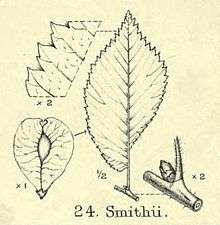Ulmus × hollandica 'Smithii'
| Ulmus × hollandica | |
|---|---|
 Leaf of 'Smithii' | |
| Hybrid parentage | U. glabra × U. minor |
| Cultivar | 'Smithii' |
| Origin | Nottingham, England |
The hybrid elm cultivar Ulmus × hollandica 'Smithii', commonly known as the Downton Elm, was one of a number of cultivars arising from the crossing of the Wych Elm U. glabra with the Field Elm U. minor. The tree was originally planted at Downton Castle near Ludlow, as one of a batch raised at Smith's Nursery, Worcester, England, from seeds obtained from a tree in Nottingham in 1810. Some Victorian writers confused 'Smithii' with U. glabra 'Horizontalis' because both featured weeping branches.[1]
Description
'Smithii' made a small tree < 10 m high, with ascending branches bearing long pendulous shoots. The oval leaves are dark green and glabrous above, < 8.5 cm long by 4.0 cm wide, long acuminate at the apex.[2][3]
Cultivation
'Smithii' was grown at the Royal Botanic Gardens Kew, and at the National Botanic Gardens , Glasnevin, Ireland, before the First World War.[4]
The Direction des Espaces Verts et de l'Environnement (DEVE) - Ville de Paris lists a 'Smithii' at the Square Louise-Michel, Paris (1990).[5]
Synonymy
- Ulmus campestris pendula: Masters Hortus Duroverni 66, 1831.
- Ulmus campestris 'Pendula': Krüssmann , Handbuch der Laubgehölze 2, p. 53, 1831–32.
- Ulmus × hollandica var. pendula (Loudon) Rehder, Mitteilungen der Deutschen dendrologischen gesellschaft 24: 217 (1915 publ. 1916).
- Ulmus glabra var. pendula Loudon, Arboretum et Fruticetum Britannicum 3: 1405 (1838).
- Ulmus montana var. Smithii Hort.: Kew
- Ulmus pendula: Masters Hortus Duroverni 66, 1831 (not Willdenow)
- Ulmus Smithii Henry: Elwes, H. J. & Henry, A. 1913. Trees of Great Britain & Ireland. Private publication.
References
- ↑ Hanham, F. (1857). A Manual for the Park (Royal Victoria Park, Bath). Longman, London.
- ↑ Green, Peter Shaw (1964). "Registration of cultivar names in Ulmus" (PDF). Arnoldia. Arnold Arboretum, Harvard University. 24 (6–8): 41–80. Retrieved 20 June 2016.
- ↑ Hilliers' Manual of Trees & Shrubs. (1977). David & Charles, Newton Abbot, UK.
- ↑ Elwes, Henry John; Henry, Augustine (1913). The Trees of Great Britain & Ireland. 7. pp. 1868–1869.
- ↑ Open Data Paris — Les arbres: Open Data Paris — Les arbres, accessdate: August 24, 2016